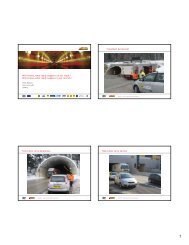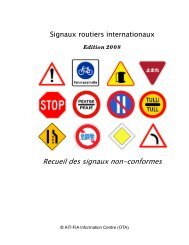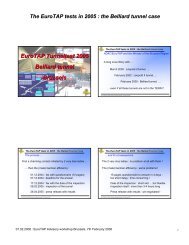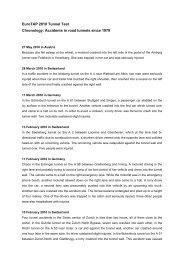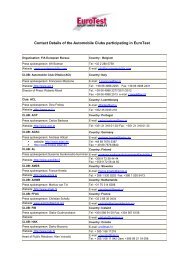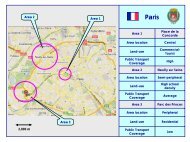EuroTAP Brochure - EuroTest
EuroTAP Brochure - EuroTest
EuroTAP Brochure - EuroTest
You also want an ePaper? Increase the reach of your titles
YUMPU automatically turns print PDFs into web optimized ePapers that Google loves.
EuroTaP for<br />
SafE TunnElS<br />
Quality | Safety | Mobility
Vice-President Jacques barrot,<br />
european Commission<br />
i very much welcome the eurotaP audit Report and<br />
the support of aDaC and its partner automobile<br />
clubs in helping to accelerate the widespread<br />
implementation of the european Directive on Safety<br />
in tunnels. across europe, well ahead of schedule,<br />
Member States are putting in place national plans<br />
backed by signifi cant investment to refurbish and<br />
raise the quality and safety of their road tunnel<br />
infrastructure. the report shows that overall the<br />
situation is very much improved, but of course there<br />
is always room for improvement.<br />
eurotaP’s collaboration with tunnel operators,<br />
authorities, experts and users has underlined the<br />
importance of good management and brought<br />
forward welcome new research and debate in the<br />
area of tunnel safety.<br />
i am very pleased with this important work and with<br />
eurotaP’s contribution to road safety.<br />
2 | 3<br />
President Peter Meyer<br />
aDaC e.V.<br />
for aDaC, europe’s biggest motoring club, consumer<br />
protection is central to our raison d’être. We are<br />
committed to it without compromise. our consumer<br />
protection activities span a broad spectrum: from<br />
crash testing to accident research; from inspecting<br />
motorway service areas to the promotion of consumer<br />
interests in mobility.<br />
eurotaP is one of our most striking consumer<br />
protection initiatives. thanks to the support of our<br />
many partner clubs we have been able to guarantee<br />
eurotaP’s success europe-wide.<br />
i would like to thank the european Commission for<br />
its support in recent years. and looking to the future,<br />
we assure you that eurotaP will continue to identify<br />
shortcomings and report them to the public to make<br />
europe’s tunnels safe.
“I regard the efforts to achieve<br />
greater safety in tunnels as an<br />
ongoing, lasting process.”<br />
Walter Steiner, operations manager,<br />
Gotthard tunnel<br />
the same horrific pictures time and again:<br />
thick black smoke bellowing out of tunnel portals,<br />
powerless fire fighters, cars burnt to a cinder. the<br />
Montblanc and tauern tunnels in 1999, Gotthard<br />
tunnel in 2001 – the most disastrous fires of recent<br />
years in europe’s tunnels.<br />
a lack of equipment, tunnels unable to cope, wrong<br />
decisions for fire fighting. the shortcomings were<br />
seared into the consciousness of the public and<br />
those in charge. it quickly became obvious that<br />
safety in europe’s road tunnels had to be improved.
the only way to achieve this was through an eu<br />
Directive, which up to then had been lacking. the<br />
preparatory work was undertaken by the uNeCe<br />
Group of experts on Safety in tunnels which met<br />
regularly in Geneva and finally tabled its<br />
recommendations at the end of 2001. top experts<br />
from all over europe were involved in this process<br />
from the very outset, along with key organisations<br />
such as PiaRC (World Road association) or CeDR<br />
(Conférence européenne des Directeurs des Routes).<br />
the motoring clubs also contributed their valuable<br />
practical experience gained from their annual<br />
tunnel tests.<br />
Club testing began in the disaster year of 1999.<br />
Since 2005, the test series has been conducted<br />
using the brand name eurotaP (european tunnel<br />
assessment Programme). the european Commission<br />
will continue backing this programme until the end<br />
of 2007.<br />
the decisive milestone on the road towards greater<br />
safety in europe’s road tunnels was the adoption<br />
of the european Directive on minimum safety<br />
requirements in the trans-european Road Network<br />
in 2004. the implementation period of this Directive<br />
will end in 2019. it is up to the Member States to<br />
fill these requirements with life and to realise the<br />
dream of safe tunnels throughout europe as soon<br />
as possible.<br />
4 | 5
“The worst I’ve ever seen.”<br />
Dr Dieter tetzner, DMt tunnel expert,<br />
after the test of Segesta tunnel<br />
No ventilation, no emergency phones, no video<br />
surveillance. With such abysmal safety features the<br />
40-year-old Paci 2 tunnel in southern italy scored<br />
almost zero points and came last in the eurotaP<br />
2007 test. Proof that the days of tunnels being<br />
empty black holes has not yet come to an end.<br />
“We know how bad we are.”<br />
Mauro antonio, surveyor, Segesta tunnel,<br />
tested “very poor” in 2006<br />
the history of european tunnel testing already began<br />
back in 1999 when aDaC was able to present to the<br />
press the latest test results from all of europe just<br />
two days after the inferno in tauern tunnel, which<br />
included the tube in which the disaster had occurred.<br />
the success in the media was outstanding because<br />
the aDaC inspectors were the only neutral experts<br />
to have inspected tauern tunnel just a short time<br />
before the accident.<br />
Henceforth, tests were conducted annually and by<br />
2004, a total of 150 tunnels had been tested. the<br />
results were published in the form of ratings. this<br />
transparency triggered something completely<br />
unknown in the field of european infrastructures:<br />
competition among road tunnels whose safety<br />
standards were suddenly visible and comparable<br />
for all.
early in 2005 a new chapter for the clubs began with<br />
eurotaP, which had the backing of the european<br />
Commission. this three-year mammoth programme<br />
combined another 150 tunnel checks with intensive<br />
education and training for motorists on how to behave<br />
correctly in tunnels. today, eurotaP is synonymous<br />
with tunnel safety throughout europe, represented<br />
by 12 motoring clubs from 11 countries: the aa<br />
(Great britain), aCi (italy), aDaC (Germany), aMZS<br />
6 | 7<br />
(Slovenia), aNWb (the Netherlands), HaK (Croatia), Naf<br />
(Norway), ÖaMtC (austria), RaCC and RaCe (Spain),<br />
tCb (belgium), tCS (Switzerland) and the european<br />
bureau of the fia (fédération internationale de<br />
l’automobile) in brussels. the partner clubs represent<br />
and defend the interests of around 34 million motorists.
“After we faired so badly, all hell broke loose here.<br />
The media circus was terrible, but after that, things<br />
got off to a very quick start.”<br />
Gregorio Rubio Manzares, manager, San Juan tunnel<br />
last place, a rating of “very poor”, ripped apart by<br />
the country’s press as europe’s worst tunnel: that<br />
was the San Juan tunnel in the south of Spain back<br />
in april 2002.“after we faired so badly, all hell broke<br />
loose here. the media circus was terrible, but after<br />
that, things got off to a very quick start”, tunnel<br />
manager Gregorio Rubio Manzares recalls. Spain’s<br />
government invested around four million euros in<br />
bringing the tunnel up to scratch. this tunnel is<br />
now a state-of-the-art safe tube. the test result in<br />
2005: “good”.
a similar series of events took place in Germany’s<br />
Kappelberg tunnel near Stuttgart. the harsh criticism<br />
expressed in the 2002 tunnel test and a rating of<br />
“poor” also gave cause for action here. around 12<br />
million euros went into refurbishing this tunnel. “We<br />
picked up on every criticism”, says andreas Klein from<br />
the Stuttgart district government. the consequence<br />
of this was a rating of “very good” in the follow-up<br />
test in 2006.<br />
the eurotaP principle of “testing – assessing –<br />
informing – improving” is repeatedly successful, and<br />
not just when it comes to individual tunnels.<br />
following the disappointing ratings in 2004 for the<br />
tuhobic and ucka tunnels in Croatia, the Croatian<br />
government responded with targeted, nationwide<br />
investments. the reward for these efforts: significantly<br />
better test ratings in the years that followed, with the<br />
brinje tunnel actually coming first in the 2007 test.<br />
the widespread publication of eurotaP has also<br />
helped the implementation of national refurbishment<br />
programmes currently underway. france, for example,<br />
is investing a good two billion euros in its tunnels.<br />
Now let’s take a look at the most important element<br />
in this safety concept: the motorist. Since 2004,<br />
eurotaP has been conducting a pan-european<br />
information campaign to train motorists in how to<br />
behave correctly in tunnels. and here there is plenty<br />
of good news. in January 2007, following a massive<br />
pile-up involving 48 cars, 150 people fled so quickly<br />
from austria’s ehrentalerberg tunnel that everybody<br />
was able to escape without injury.<br />
8 | 9<br />
“We picked up on every criticism.”<br />
andreas Klein, Stuttgart district government,<br />
on Kappelberg tunnel
over the past three years, the eurotaP inspectors<br />
have travelled more than 125,000 kilometres, which<br />
is equal to three times around the world. on their<br />
travels, they visited 152 tunnels in 18 countries,<br />
inspected them extensively and assessed their level<br />
of safety.<br />
the results which they brought home with them<br />
are primarily good. 60 percent of europe’s most<br />
important road tunnels demonstrated a high level<br />
of safety and were rated “good” or “very good”.<br />
Coming out on top were the test winners: tying for<br />
fi rst place in 2005 were the Markusberg tunnel in<br />
luxembourg and the ottsdorf tunnel in austria, the<br />
2006 winner was the M-12 tunnel in Spain, and in<br />
2007, the brinje tunnel in Croatia.<br />
“In the 2007 <strong>EuroTAP</strong> tunnel test<br />
every fi fth tunnel was shown the<br />
red card due to considerable<br />
shortcomings in safety – too many<br />
in the age of state-of-the-art tunnel<br />
philosophy.”<br />
Nicolas adunka, test manager, aDaC<br />
but still, 21 percent and hence more than one in<br />
fi ve of the tunnels tested over the past three years<br />
failed to meet the minimum standards specifi ed by<br />
the european tunnel Directive. to put it in concrete<br />
fi gures: 12 ratings of “poor” and 19 ratings of “very<br />
poor” were issued. and it literally rained “poor”<br />
ratings in those countries with the most tunnels,<br />
i.e. Norway and italy. two thirds of tunnels failed to<br />
make the grade in italy, as did half of the tunnels<br />
in Norway.<br />
in the statistical comparison of countries, Croatia<br />
and Slovenia delivered a positive surprise, heading<br />
the fi eld here. However, these two countries have<br />
only a limited number of tunnels, all of which are still<br />
relatively new. this makes austria’s third place all<br />
the more valuable in light of this country’s diffi cult<br />
topography and long tunnel tradition.
the most serious lacunas in safety were found in<br />
the following areas: escape and rescue routes, fire<br />
protection, ventilation and traffic monitoring. the<br />
most important and most frequent shortcomings:<br />
single-tube tunnels with bi-directional traffic, no<br />
emergency exits or exits situated too far apart, no<br />
escape routes or poorly signposted routes, no<br />
10 | 11<br />
automatic fire alarm systems, no fire extinguishers,<br />
no video surveillance or only in certain sections, and<br />
distances far too long for rescue services to cover.
“We must ensure that best practices<br />
are spread throughout the whole Union.”<br />
ari Vatanen, MeP<br />
Nobody knows what it will cost to implement the<br />
european tunnel Directive. in 2002, the european<br />
Commission put the price at around six billion euros.<br />
the fact is, as the eurotaP results show, that at least<br />
a fifth of europe’s most important tunnels do not<br />
provide a sufficient level of safety. Still, the Member<br />
States must implement by 2014, in exceptional<br />
cases by 2019. this is a huge task, not just in<br />
financial terms.<br />
in 2001, the european union set the target to<br />
reduce by half the number of fatalities on europe’s<br />
roads by 2010. Safer tunnels will contribute to this<br />
goal. eurotaP has shown that more than half of the<br />
tunnels tested have standards of safety that exceed<br />
the level demanded by the eu. the european<br />
Commission has proposed a new directive that seeks<br />
to achieve uniform levels of safety across the entire<br />
road infrastructure which is similar in its objectives<br />
to the tunnel Directive. it goes without saying that<br />
this will also call for safer vehicles and careful users.<br />
in tunnels, safety also includes staff and emergency<br />
teams. in italy’s San Martino tunnel, it took rescue<br />
services a total of 45 minutes in September 2007<br />
to reach the site of an accident. this delay cost two<br />
people their lives and more than 100 people<br />
suffered from smoke inhalation.
When it comes to training tunnel staff, eurotaP<br />
proposes the use of low-cost, interactive, computersupported<br />
training programmes. europe’s motoring<br />
clubs started to educate and train motorists in 2004<br />
with the launch of the pan-european “Safe tunnels”<br />
campaign. this work has been continued by eurotaP.<br />
12 | 13<br />
along with further inspections, this unique programme<br />
will continue to closely monitor the implementation<br />
of the european tunnel Directive and to inform<br />
motorists. the common goal: safe tunnels throughout<br />
europe in 12 years from now at the latest. according<br />
to ari Vatanen, european parliamentarian: “We must<br />
ensure that best practices are spread throughout the<br />
whole union.”
“eurotaP fits precisely into the eu’s goal to cut by half<br />
the number of fatalities on europe’s roads by 2010.<br />
We are grateful for the enormous contribution that has<br />
been made up to now and eagerly await the continuation<br />
of the programme.”<br />
“the fia and the many associated motoring clubs have<br />
gone to great lengths to make transport and daily mobility<br />
more safe. eurotaP and its success in achieving greater<br />
tunnel safety are a very important part of this work. We<br />
will continue to promote this programme in the future.”<br />
“the principle of eurotaP works time and again: we<br />
test, we exert public pressure via the media, and those<br />
in charge respond by investing and refurbishing. this<br />
results in safer tunnels and everybody benefits.”<br />
Professor Reinhard Rack,<br />
MeP/Rapporteur eu Directive<br />
Werner Kraus,<br />
President fia Region 1<br />
Robert Sauter,<br />
eurotaP Chairman
System requirements:<br />
· System: PC (Windows XP or Vista)<br />
· Processor: minimum 1.2Ghz<br />
· active store: minimum 512Mb<br />
· Resolution: minimum 1024 x 768 pixel<br />
· Sound: 16-bit sound card<br />
(for video sound)<br />
· Device: CD-RoM<br />
installation/Handling note:<br />
· autostart and<br />
stand-alone application<br />
· No installation required<br />
· Starting file: eurotaP.exe<br />
euRotaP oN CD<br />
after three years of eurotaP and 152 tunnel tests in<br />
18 countries you can now read the comprehensive<br />
technical report detailing all aspects: test results,<br />
analyses, solutions. With the report comes an<br />
14 | 15<br />
interactive teaching game on how to behave correctly<br />
in tunnels, the eurotaP fi lm plus the eurotaP<br />
information leafl et. everything compiled on one CD!<br />
So simply pop the CD into your computer and discover<br />
for yourself the world of eurotaP.
Publisher:<br />
aDaC e. V.<br />
am Westpark 8<br />
81373 Munich<br />
Germany<br />
www.adac.de<br />
Responsible for contents:<br />
Robert Sauter<br />
aDaC e. V.<br />
editing:<br />
Caroline ofoegbu<br />
fia european bureau<br />
Project management for brochure:<br />
Nicolas adunka<br />
aDaC e. V.<br />
Contact:<br />
Nicolas.adunka@adac.de<br />
www.eurotap.eu<br />
Photos:<br />
Photo ullrich (frohnleiten, a)<br />
yägverket Region Stockholm (Solna, S)





